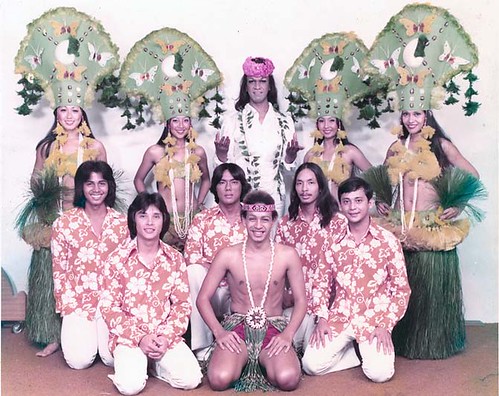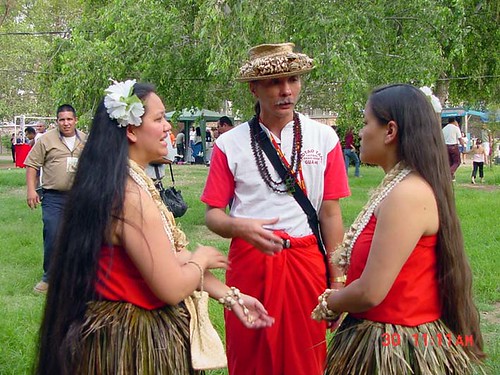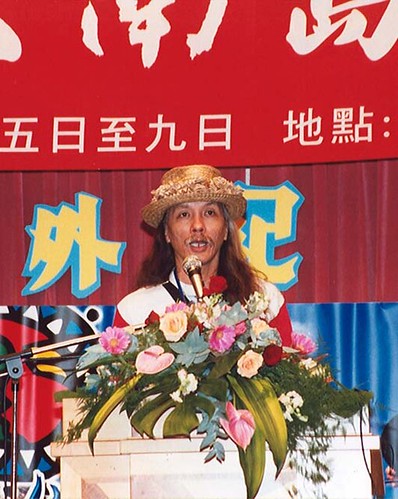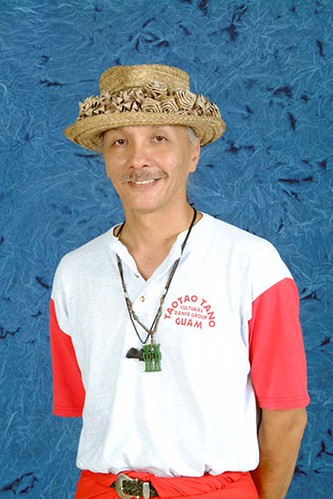Contemporary Chamorro cultural dance
Francisco “Frank” Rabon (1954 – ) is the founder and director of the Taotao Tano’ Cultural Dancers, whose name is synonymous with cultural dance practices in Guam. After founding the Taotao Tano’ Cultural Dance group in 1983, he continued to advance in the field of cultural dance, most notably to personally research Chamorro history, origins, migration, connection and reconstruction of indigenous Chamorro dances, chants and songs.
Rabon was born in Guam in 1954 and has spent most of his life on the island. He is the seventh of 10 children born to Jesus Bontugan and Rosa Benavente Rabon.
In 1972, Rabon graduated from John F. Kennedy High School in Tamuning, Guam. After high school, he took courses on psychology, sociology, criminal law, and studied the Freud and Gestalt theories of human behavior from the University of Guam, San Mateo Community College, Seattle Central Community College and University of Washington. He started his research in Chamorro history and dance in 1971 after being exposed to indigenous cultural dancing in 1970, under the direction of Kumu Hula Janelle Kawa, from Hawai’i.
As a recognized hula specialist, Kawa taught Rabon indigenous Pacific dances in its truest form, as it was passed down from generation to generation. In 1972, Rabon performed with Ui Lani O Polynesia at the Hilton Guam, where he started to absorb and compare the similarities in dance forms of different island groups within the Pacific region. Rabon left Guam in 1976 to pursue his education in the US mainland, but continued dancing whenever he had the opportunity in Hawai’i, Washington, Oregon and California.
Having been raised with local traditions, Rabon speaks, writes and reads the Chamorro language fluently and is very familiar with Chamorro customs. It is this upbringing that he credits as the source of his fascination with the history and culture of the islands. Because of it, he holds dear to his heart the importance of his ancestral traditions, knowing just how much has been lost through outside influences. Rabon also understands and deeply respects others who are struggling to preserve their heritage.
Rabon recounts that, growing up, he was more exposed to the borrowed Chamorro traditions, along with 400 years of Spanish influence and American contemporary dance. He found that information concerning the Taotao Tano’ period prior to Western contact was never taught simply because it was not accessible or available. Eventually, books, manuscripts and periodicals surfaced about the origins of the Chamorro people and Mariana Islands history. This information sparked even more interest in Rabon, and from there, he ventured into researching more about his ancestors, particularly in the field of chanting, songs and ceremonial dances.
Once he discovered a passion for dance, he dedicated his life toward re-creating, perpetuating and educating others on the existence of Taotao Tano’. In 1983, he formed the Taotao Tano’ Cultural Dancers organization.
The group exists with the mission:
(1) That we take from the past combined with the present and build for the future. (2) That we instill in future generation the pride of the existence of the Chamorro people and her traditions. (3) That through performances we educate and share, to others, the uniqueness, of the indigenous traditions of our people. (4) That we respect others of culture in their struggles to preserve their indigenous traditions.
This was the beginning of the 28 years Rabon has devoted to re-creating and re-establishing the indigenous Chamorro culture of songs, dances and chanting.
Rabon has been bestowed the honor of “Master of Chamorro Dance” as well as given the “Lifetime Achievement Award” by the Guam Council of the Arts and Humanities (CAHA) in recognition of his accomplishments in cultural dance practices of Guam.
As a performing group, the Taotao Tano’ Cultural Dancers have been to many countries to share the beauty of the island’s culture in this ever-changing world.
As educators, we have to strive to instill a sense of identity to the people of Guam, and the importance of preserving and perpetuating the traditions of our ancestors. We continue on the path that our ancestors have struggled on before us, knowing that we have only started to rekindle the fire that burns within the hearts of our people.
Through a partnership with the late Speaker Carlos Taitano, Rabon created the nonprofit organization Pa’a Taotao Tano’ (A Way of Life of the People of the Land) in 1998 as a way to apply for federal grants through the Administration of Native Americans (ANA) so that they could further the mission of cultural preservation, perpetuation, promotion and education of the Chamorro culture.
As the creative director of Pa’a Taotao Tano’, Rabon has provided cultural services to the community of Guam, through the Department of Education, the Guam Visitors Bureau and the Government of Guam’s cultural agencies. In the years of Pa’a Taotao Tano’s existence, it has created the annual Dinana Minagof Chamorro Dance Competition/Festival in partnership with Gef Pa’go, Inalahan; established the Northern Cultural Arts Program; received funding from the Serve Guam Commission to establish the Pa’a/AmeriCorps Volunteers Program; received a three-year language implementation grant from ANA to collect and document the Chamorro language through songs and chants; and many other accomplishments.
Rabon continues his research and education on Guam’s cultural dance practices and shares not only with people on Guam, but people worldwide.
For further reading
Guam Council on the Arts and Humanities Agency. “Artists – Guam CAHA.”
I Manfayi: Who’s Who in Chamorro History. VoI. 3. The Hale’-ta Series. Hagåtña: Department of Chamorro Affairs, Division of Research, Publication, and Training, 2002.






